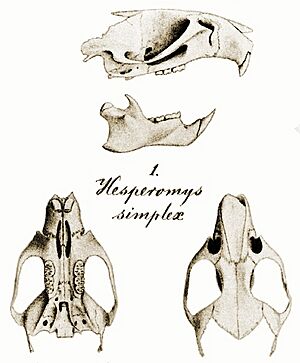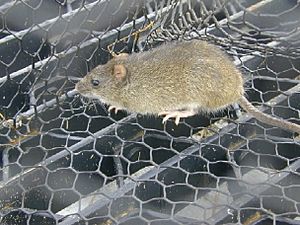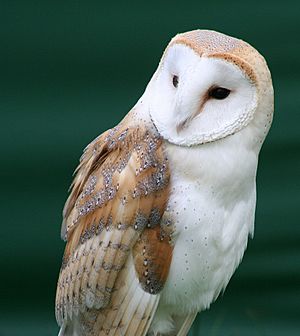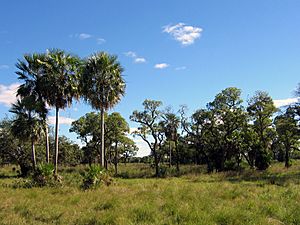Brazilian false rice rat facts for kids
Quick facts for kids Pseudoryzomys simplex |
|
|---|---|
 |
|
| Lectotype skull as illustrated by Winge in 1888 | |
| Conservation status | |
| Scientific classification | |
| Genus: |
Pseudoryzomys
|
| Species: |
simplex
|
 |
|
| Distribution of Pseudoryzomys in South America (in red); fossil record from Cueva Tixi, eastern Argentina, in blue | |
| Synonyms | |
|
|
The Pseudoryzomys simplex, also known as the Brazilian false rice rat, is a type of rodent found in south-central South America. It lives in warm, grassy areas with palm trees or thorny bushes. This medium-sized rat weighs about 50 grams (1.8 ounces). It has gray-brown fur, long and thin back feet, and a tail that is about the same length as its head and body. The IUCN says it is of least concern for its survival. This means it is not currently in danger. However, scientists still know very little about what it eats or how it reproduces.
This rat is the only species in its group, called Pseudoryzomys. Its closest living relatives are two larger rats, Holochilus and Lundomys. These relatives spend a lot of time in the water. All three types of rats share some special features. For example, they have small webs between their toes, which helps them in water. Their teeth are also less complex than other rats. These features are just starting to show in the Pseudoryzomys. These three groups of rats form a special family within a larger group called the oryzomyine tribe. This tribe has over a hundred species, mostly in South America. The Pseudoryzomys simplex was first described in 1888 from old bones found in a cave in Brazil. Later, in 1921, a live one was found in Paraguay and given a different name. In 1991, scientists confirmed that both names were for the same species.
Contents
How the Brazilian False Rice Rat Was Discovered
The Pseudoryzomys simplex has a confusing history of how it got its name. It was first described in 1888 by a Danish scientist named Herluf Winge. He studied old bones found in caves in Brazil. Winge called this species Hesperomys simplex. For many years, most scientists did not pay much attention to this name.
Then, in 1921, a famous British scientist named Oldfield Thomas described a new rat species from Paraguay. He called it Oryzomys wavrini. For a while, scientists thought this was a strange type of Oryzomys. But in 1959, another scientist, Philip Hershkovitz, said it was different enough to have its own group, which he named Pseudoryzomys. He thought it looked like a marsh rice rat but was more closely related to other groups of rodents.
Over the years, scientists learned more about the rare Pseudoryzomys wavrini. In 1975, rats from Bolivia were named a separate type because they were a bit bigger and darker.
In 1980, an Argentinean scientist suggested that the old bones Winge found and the living Pseudoryzomys wavrini were actually the same animal. In 1991, American scientists confirmed this idea. They looked at Winge's old bones again and found no real differences. Because Winge's name, simplex, was given first (in 1888), the animal is now officially known as Pseudoryzomys simplex. The other names became older, less used names for the same animal.
What Does the Brazilian False Rice Rat Look Like?
The Pseudoryzomys simplex is a plain-looking, medium-sized rat with soft, long fur. Its back and sides are gray-brown, and its belly is a light yellowish-brown. The colors blend smoothly. Its small ears have short hairs. The tail is dark on top and light underneath. It is about the same length as its head and body, or a little longer. Even though it has short hairs, you can still see the scales on its tail. The hairs on its feet are light-colored.

Its back feet are long and narrow, with five toes. The first and fifth toes are short. It has small webs between its second, third, and fourth toes. These webs are not as big as those on its relatives, Lundomys or Holochilus. The hair tufts on its toes and some of its foot pads are small. These are common features for rats that spend time in water.
The head and body length of this rat is about 9.4 to 14 centimeters (3.7 to 5.5 inches). Its tail is 10.2 to 14 centimeters (4.0 to 5.5 inches) long. Its hindfeet are 2.7 to 3.3 centimeters (1.1 to 1.3 inches) long. Its ears are 1.3 to 1.9 centimeters (0.5 to 0.7 inches) long. The rat weighs about 45 to 55 grams (1.6 to 1.9 ounces).
The Skull of the Rat
The skull of the Pseudoryzomys simplex is short at the front. It has some features typical of its group. The roof of its mouth (palate) is long, going past its molar teeth. There is no bone structure that separates two openings in the skull. The front part of the skull is short.
The bones at the front of its nose end bluntly. The narrow area between its eyes gets narrower towards the front. A bone on the top of its skull, called the interparietal bone, is almost as wide as the frontal bones.
The openings in the roof of the mouth, called incisive foramina, are long and narrow. They are located between the front teeth and the molars. The back edges of the cheekbones are located before the first molars. Like its relatives, Lundomys and Holochilus, Pseudoryzomys has pointy parts on its cheekbones. These rats also have simple holes in the palate near the third molar. However, unlike its relatives, Pseudoryzomys has a flat palate without a ridge in the middle.
The lower jaw is short and deep. An opening at the front of the lower jaw, called the mental foramen, opens to the side. The bone at the back of the lower incisor tooth is well developed. The two ridges where chewing muscles attach are completely separate.
The Rat's Teeth
Like most rats in its group, the molars (back teeth) of the Pseudoryzomys simplex are low-crowned. This means the chewing surfaces are not very tall. They have strong bumps (cusps) and very few extra ridges. The bumps on the upper molars are directly opposite each other. But on the lower molars, the outer bumps are slightly more forward than the inner ones.
On the first upper molar, one extra ridge is missing, but another is present. Unlike most other rats in its group, the Pseudoryzomys's extra ridge is short. The corresponding structure in the lower molars is completely missing. The very back valley between the bumps on the first lower molar is very small. This shows how it is related to Lundomys and Holochilus. Many features of its molars show its connection to Holochilus and Lundomys.
Like all rats in its group, the upper molars have one root on the inside and two on the outside. The first upper molar in Pseudoryzomys also has another root on the outside. The first lower molar has large roots at the front and back, and two smaller ones in between. The second and third lower molars have two roots at the front and one at the back.
Bones Beyond the Skull
The Pseudoryzomys has 19 or 20 bones in its chest and lower back. Thirteen of these bones have ribs attached, which is typical for its group. The first ribs touch both the seventh neck bone and the first chest bone. This is an important feature of its larger family. Unlike most rats in its family, the fourth lower back bone does not have certain bony growths. It has three or four bones in its hip area and about 29 tail bones. Between the second and third tail bones, there are separate bones that have a pointy part at the back. This is also seen in Holochilus and Lundomys. The upper arm bone (humerus) does not have a hole near its end, which is common for all members of its family.
Chromosomes and Genetics
The Pseudoryzomys simplex usually has 56 chromosomes. This is true for rats from both Bolivia and Brazil. In this setup, all chromosomes that are not sex chromosomes are shaped like a rod. However, in two rats from Brazil, one pair of these chromosomes has one rod-shaped and one X-shaped chromosome. This kind of difference has been seen in other rodents too. The sex chromosomes (X and Y) are both rod-shaped. The X chromosome is larger than the Y chromosome. The Y chromosome has two large blocks of special genetic material. The chromosomes of Pseudoryzomys simplex are very similar to those of Holochilus brasiliensis.
Where the Brazilian False Rice Rat Lives

The Pseudoryzomys simplex is found in many places in South America. It lives in northeastern Argentina, and goes north through western Paraguay to eastern Bolivia. From there, it spreads eastward through Brazil. Rats from Paraguay are a bit smaller than those from Bolivia and Brazil. Bolivian rats have darker fur than Paraguayan ones. But these differences are not big enough to call them separate types. Some bats show similar changes in size and color in the Chaco region, which includes much of Paraguay.
This rat has been rare in collections. In 1991, scientists only had fewer than 50 specimens to study. A piece of a lower jaw from a Pseudoryzomys was found in a cave in Argentina. This cave is outside where the species lives today. This old jaw is from about 1,000 years ago. It looks like the modern Pseudoryzomys simplex, but its tooth row is a bit longer.
Pseudoryzomys simplex lives in open, often wet, tropical and subtropical lowlands. In Argentina, it mainly lives in the eastern Chaco region. In Brazil, it is found in the Cerrado and Caatinga areas. Most of these rats were caught on the ground in wet grasslands, some in areas that flood seasonally. One rat in Argentina was caught in thick swamp plants. This rat lives on the ground but also spends time in the water.
Scientists do not know much about its behavior or what it eats. Pseudoryzomys simplex bones have often been found in the pellets (regurgitated undigested food) of barn owls and great horned owls. This shows that owls hunt them. It is also a favorite food of the maned wolf.
Is the Brazilian False Rice Rat in Danger?
The Pseudoryzomys simplex is not thought to be in danger. Its conservation status is listed as least concern by the IUCN. It lives in a wide area and does not face major threats. However, if its habitat is destroyed, some groups of these rats could be at risk. In Argentina, it was once considered "potentially vulnerable."



